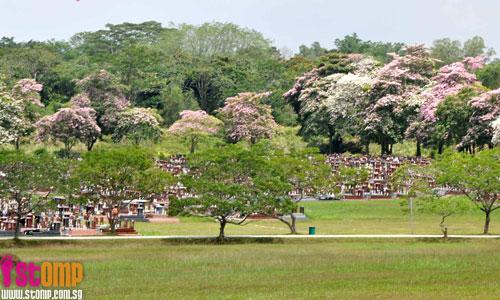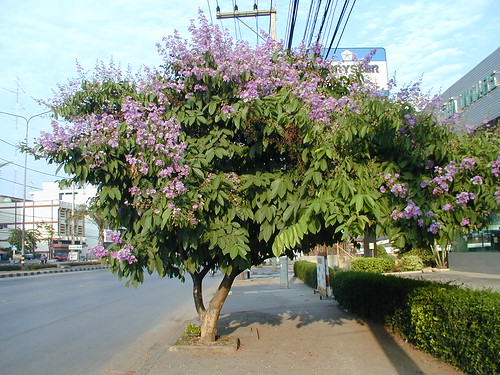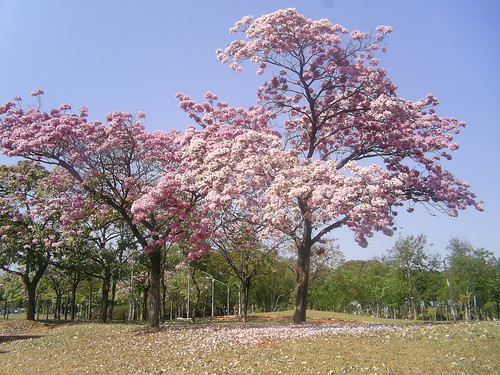
STOMPer global netizen saw these beautiful pink and white flowers at the Choa Chu Kang Christian cemetery and wondered whether they were the famous Japanese cherry blossoms, known as sakura.
This STOMPer says:
"Sakura in Singapore? So nice and beautiful.
"It can be seen at the Choa Chu Kang Christian Cemetery foot path, once a year.
"This is the season to see such a beautiful scene. It is so peaceful and tender.
"It is not the real sakura, but it is white and pink. Anyone knows what kind of flower is this?"

Sakura (kanji: 桜 or 櫻; hiragana: さくら) is the Japanese name for cherry trees (Prunus spp.) and their blossoms, although the term in English usually refers to the ornamental varieties of cherry, which produce inedible fruit. The mass flowering of cherry trees is most often associated with Japan, although similar episodes do occur elsewhere in temperate parts of the world. The Wikipedia page on cherry blossoms provides some useful information on the importance of this phenomenon in Japanese culture.
I'm not too sure about the identity of the trees in this post; they could be pink mempat (Cratoxylum formosum) (also known as the Singapore sakura), rose of India (Lagerstroemia speciosa), or trumpet tree (Tabebuia rosea). Two or more species might also be involved. Without photographs showing the flowers and leaves in greater detail, it's difficult for me to narrow it down further. My knowledge of Singapore's flora is extremely poor, so I hope someone else is able to identify these trees.
Update: This post over at Garden Voices leads me to believe that the trees in question are trumpet trees.
A post from 23rd November 2006 documents a similar mass flowering event in Ang Mo Kio.

Pink mempat, East Coast Park
(Photo by Artistic Creations)
Many of these trees were planted for ornamental purposes. According to The Natural Heritage of Singapore:
The second phase in the 1980s saw planting of species with colourful flowers like the yellow flame (Peltophorum pterocarpum) with its numerous yellow blooms, flame-of-the-forest (Delonix regia) with its scarlet flowers which can be seen from great distances, rose of India (Lagerstroemia speciosa) with its bluish purple flowers, golden shower (Cassia fistula) with its striking, numerous blooms like hanging streamers, mempat (Cratoxylum formosum or Cratoxylum cochinchinense) which shed their leaves and then produce numerous pink blooms in the whole crown like a local version of the cherry blossom, trumpet tree (Tabebuia rosea) which produces heavy flushes of white or light to dark pink flowers, etc. This colour exercise met patchy success as many of these species required strong seasonal cues to flower, being native to more seasonal climes, unlike the rather aseasonal Singapore climate, so colour was not always on tap, unless an atypical drought period was experienced locally, then trees would synchronously bloom in the following wet period.
Given that Singapore was slowly wilting under the heat of a particularly bad dry spell for much of January and February, and also taking into account the fact that we have finally received some much-needed relief in the form of heavy afternoon showers over the past few days, it's not surprising that these trees have flowered in response.

Rose of India, Thailand
(Photo by autan)
I found an article on this blog called the Human Flower Project, which dates back to March 2005, about a similar mass flowering episode which occurred in Singapore at that time.
Singapore's Pink Rain

Trumpet tree, Brazil
(Photo by C.Lisboa)
The pink mempat is a native of the region, the rose of India hails from southern Asia, whereas the trumpet tree is an exotic species native to tropical Central and South America, from southern Mexico to Venezuela and Ecuador.
It is interesting to note that a few other tree species found in Singapore, such as the tembusu (Fagraea fragrans) and sea apple (Syzygium grande), will occasionally synchronise their flowering, such that nearly every mature tree in Singapore can be seen flowering at the same time. One such example was seen with the sea apple in October 2007; this phenomenon was documented over at Habitatnews.
Such mass flowering events are not only pleasing to the eye, but also attract a wide variety of insects, birds and small mammals such as squirrels and bats, which visit the flowers to feed on nectar and pollen. Other species that don't feed on nectar may also derive some benefit; insectivorous birds may flock to these trees to feed on the insects attracted to the flowers.
Here are a few relevant posts over at the Bird Ecology Study Group:
Nectar party at the saraca tree
Syzygium sp. and the birds it attracts
Flowering umbrella tree (Schefflera actinophylla) and birds
Saraca and sunbirds
The mempat tree
Flowering Sea Apple Trees at Sime Forest
I wonder if other tree species are also going to bloom as a result of this change in weather.